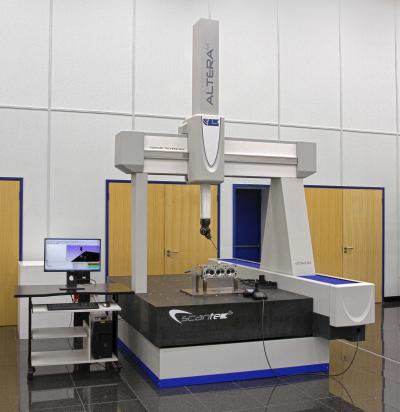
LK Metrology Inc. has introduced a new ALTERA coordinate measuring machine called the SCANtek 5, which is coupled with Renishaw’s REVO-2 scanning system and multiple-sensor technology to offer manufacturers a 5-axis solution for inspecting dimensional accuracy and surface finish of components.
The ALTERA SCANtek 5 features a ceramic construction of the CMM beam and spindle, which combines optimal stiffness-to-weight ratio for exceptional responsiveness with mechanical and thermal stability for consistent performance across all manufacturing environments.
The SCANtek 5 multiple-sensor package includes Renishaw's MODUS software for importing data, controlling the CMM, acquiring results and reporting, including GD&T (geometric dimensioning and tolerancing) labelling. The machine's high scanning speed of 500 mm per second boosts measurement throughput, shortens production lead-times, provides a comprehensive awareness of product conformance and prevents the metrology department from becoming the bottleneck in the factory.
SCANtek 5 is available with a variety of standard measuring volumes from 800 x 700 x 600 mm (8.7.6) to 6,000 x 2,000 x 1,000 mm (60.20.10), with larger options. ALTERA M models with repeatability from 1.5 µm are being marketed alongside an ALTERA SL range offering repeatability from 0.7 µm.
The SCANtek 5-axis CMM gives users a competitive advantage, making it easier to win new work and helping to bring products to market faster. A 3-axis measuring solution, by contrast, is often unable to measure some complex features. With the REVO-2 head synchronized with constant velocity machine motions when scanning, allows changes in component geometry to be followed without introducing dynamic errors.
SCANtek 5 scans without the stylus leaving the surface of the component allowing coordinates of up to 4,000 points to be captured "on-the-fly" every second, a rate of data acquisition far higher than is possible using conventional probing techniques. It is also possible to include rapid, single-touch routines into a measuring cycle. The flexibility offered by infinite head positioning increases the effective measuring volume by minimizing the need for head reorientations, while allowing highly complex measuring. Exchanging the REVO-2 scanning probe for one of the vision probes can further increase data collection rates and the results can be correlated accurately with those acquired using tactile methods.
In addition, by employing different tip arrangements and knuckle joints, detailed surface finish analyses can be combined with other CMM measurements in a single operation, the basic output being Ra, RMS and raw data, with an extensive range of additions provided by standard and advanced surface texture options. Even fine bores down to 5 mm in diameter can be inspected. A variety of change racks, up to one meter in length, are available for housing sensors, probes and styli to enable automatic exchange during a measuring sequence.
The MODUS software with its user-configurable interface provides a powerful platform for creation of programs, either by teach mode or from a CAD model imported via the usual graphical exchange formats or directly from CATIA, Siemens NX, Parasolid, PTC Creo or Solidworks. Wizards in the Windows programming environment employing conversational, graphical and drag-and-drop methodologies give access to a range of macros and standard scanning routines such as helical, circular and sweep to ensure best practice metrology, without the need for specialist programming skills. The native DMIS (Dimensional Measuring Interface Standard) program with drawing geometry, dimensions and tolerance data embedded can be simulated offline to check for potential collisions before the inspection cycle is run on the SCANtek 5.
A wealth of textual and graphical reporting functionality is offered, including multiple-part inspection for series production and real-time reporting during program execution. Data exchange to third party applications such as Excel, XML or SQL is provided, as well as to Q-DAS for statistical process control.
Contact Details
Related Glossary Terms
- computer-aided design ( CAD)
computer-aided design ( CAD)
Product-design functions performed with the help of computers and special software.
- metrology
metrology
Science of measurement; the principles on which precision machining, quality control and inspection are based. See precision machining, measurement.
- process control
process control
Method of monitoring a process. Relates to electronic hardware and instrumentation used in automated process control. See in-process gaging, inspection; SPC, statistical process control.
- statistical process control ( SPC)
statistical process control ( SPC)
Statistical techniques to measure and analyze the extent to which a process deviates from a set standard.
- surface texture
surface texture
Repetitive or random deviations from the nominal surface, which form 3-D topography of the surface. See flows; lay; roughness; waviness.
- tolerance
tolerance
Minimum and maximum amount a workpiece dimension is allowed to vary from a set standard and still be acceptable.
